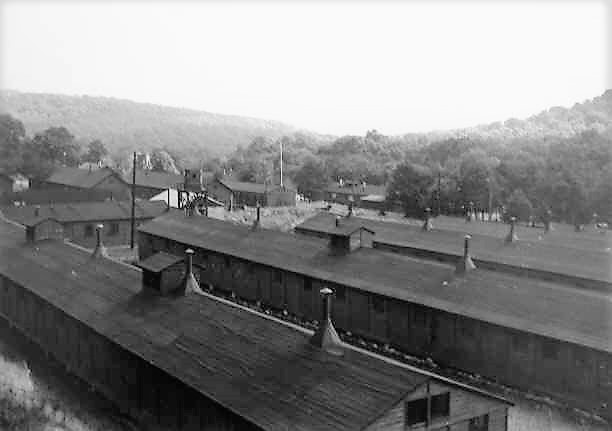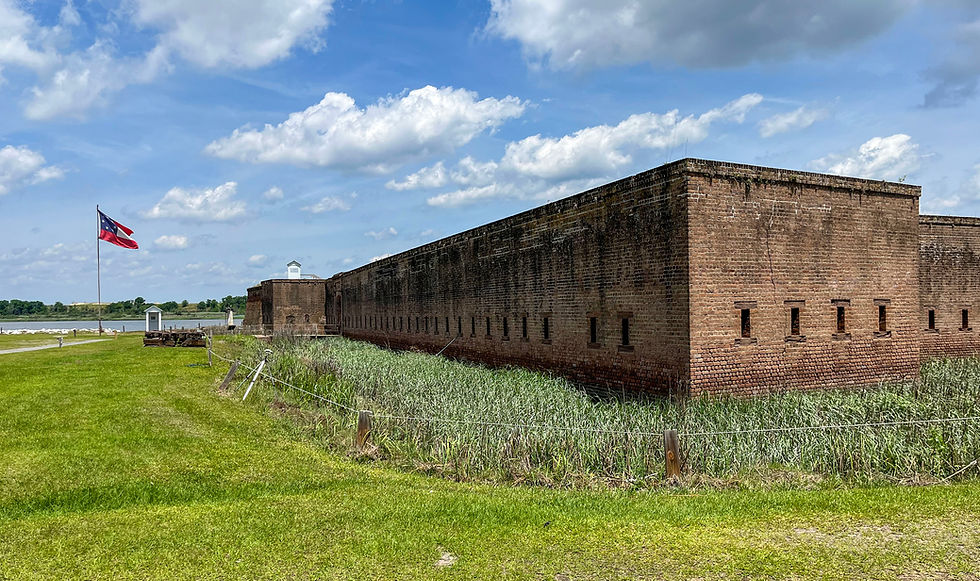Pine Grove Furnace and Sunset Rocks Trail
- Tim Murphy

- Mar 10, 2018
- 6 min read
Updated: Apr 24, 2021
Needing a rebound from my last hiking experience at Signal Knob, I ventured up to Pennsylvania's Michaux State Forest to hike the Sunset Rocks Overlook Trail. This 7.3-mile loop is a branch of the Appalachian Trail and originates in Pine Grove Furnace State Park. While my original intention for the trip was to hike, I soon realized there's much more to discover than just trails and views. From a boom-and-bust iron works community to a World War II prisoner-of-war camp, a multitude of historical secrets dwell within the woods of Michaux.

In 1764, George Stevenson, Robert Thornburgh, and John Arthur constructed the Pine Grove Iron Works. The plant produced iron for stoves and kettles, but reportedly manufactured munitions during the Revolutionary War. In 1782, Pine Grove was sold to Michael Ege. His son, Peter, built the Iron Masters Mansion overlooking the facilities in 1829. The mansion still stands prominently today and is used as a hostel for AT hikers. Tours of the house are also offered between April and November.
The Panic of 1837 disrupted production at the plant and Ege was forced to sell. For a short time, the iron works were under the direction of Frederick Watts and Charles Penrose, the former went on to found Penn State and the latter was Solicitor of the Treasury for President William Henry Harrison.
By 1864, the company was owned by Jay Cooke. Known as the "Financier of the Civil War," Cooke raised $1.2 billion through the sales of government bonds and treasury notes. Thanks to the commission of those bonds, he was the richest man in America shortly after the war. He constructed the South Mountain Railroad to help transport Pine Grove's raw materials to bigger cities and saw some success. Unfortunately for Cooke, his luck and his riches would not last long. After numerous failed business ventures in the West, Cooke declared bankruptcy in 1873. The closing of Cooke's company started a domino effect that resulted in the financial panic of 1873.
Cooke was able to buy the furnace back in 1877 and founded the South Mountain Mining and Iron Company. While the next few years would see some of the plant's greatest production, new technologies and larger corporations made smaller operations obsolete. Pine Grove Furnace went out of blast in 1895, ending its 130-year iron-making history. One of the main furnace stacks can still be seen today, standing as a testament to the thriving industrial operation that once dominated this landscape.

A few other structures from that era still stand, too, including the Grist Mill (c. 1790), which is now the Appalachian Trail Museum. The museum is open from April to December and features personal artifacts from the AT's founders, old trail shelters, and thousands of pictures from the countless through-hikers who have visited over the years. Pine Grove State Park is the perfect place for this museum, considering it is the halfway point between Mount Katahdin, Maine, and Springer Mountain, Georgia, the termini of the trail. It is tradition for all through-hikers who stop here to take part in the Half Gallon Challenge (basically you eat a half-gallon of ice cream at the park's general store and get a commemorative wooden spoon...something to look forward to when I hike the AT in 2021).
Anyway, back to the trail itself. As stated before, the origin of this trail is in Pine Grove State Park; however, it's a little odd to start out. The first two-tenths of a mile are walked on paved public roads. Starting from the furnace stack, I followed the white blazes going South on the AT (walk down Bendersville Rd and past the Iron Masters Mansion). I made a left on PA-233 and walked for a couple hundred yards before finally getting to the trail head on the right-hand side of the road. From there, it's much easier to follow. The trail is fairly wide, easy to walk on, and not particularly steep in any areas before the Sunset Rocks trail (these were old logging roads so it makes sense).
I followed the AT for a little over a mile before getting to the trail intersection. This is easy to find since there is a roaring stream a few feet away and a blue-blazed trail sign that says "Sunset Rocks." I took a left and followed the blue blazes for about a third of a mile. This is when things got tough--in a good way though. The trail suddenly became incredibly steep with grades over 40 degrees in some areas! It's pretty intense the rest of the way up to the top of Little Rocky Ridge. Personally, I love trails that challenge my power and endurance, and this section of the trail surely didn't disappoint. I didn't want to see a stair-stepper machine for a few days after that.

At the top of the ridge, I took a left to see the view, which is few hundred feet away. The two jagged boulder outcrops at the end of the trail are Sunset Rocks. Though the area around the overlook is rather small, you get an absolutely phenomenal view of the Michaux Forest! I can hardly imagine what it looks like in autumn when the leaves have changed color. After taking in the view, I doubled-back down the trail and followed the rest of the path along the ridge-long rock scramble. I had a blast climbing up, over, and around the huge boulders on this terrain!
About a mile from Sunset Rocks, the trail intersects Old Michaux Rd. I followed the road for a short distance and hopped back on the blue blazes until I got to Toms Run Shelter. According to local legend, there are three unmarked graves of children who died of smallpox near the camp site (which makes the thought of me hiking this alone more unsettling). From the shelter, I connected to the Appalachian Trail and walked northbound back to Old Michaux Rd. I followed the road again until I got to Bunkerhill Rd. Yes, technically, this is not part of the trail. However, this intersection is the location of Camp Michaux, the WWII POW camp!
The land was originally used as a tenant farm for the South Mountain Mining and Iron Company in the early 1900s. In 1912, the 250-acre parcel was sold to the state and left to deteriorate. In 1933, the Civilian Conservation Corps (CCC; one of FDR's social welfare programs to address the widespread unemployment of the Great Depression) established a forestry worker's camp here. Known as Camp S-51, this was the first CCC camp in the state of Pennsylvania. Two hundred men, ages 18-25 (many of whom came from Fort Monroe, VA), built roads, installed telephone wires, and constructed the infrastructure for the future state parks in the region.
In 1942, Camp S-51 was turned over to War Department and converted into the Michaux Prisoner of War Camp. In its three years as a POW camp, around 7,300 German and 160 Japanese soldiers were interned here and interrogated by US Intelligence officers. After the war, the camp was used as a church retreat. In 1972, the camp was abandoned and its buildings demolished three years later. Today, the forest has reclaimed the camp, but you can still walk around the grounds and visit the remnants of structures that once dominated the landscape.

After exploring the ruins, I got back onto Bunkerhill Rd and followed it to the Appalachian Trail. It's a short walk to the creek and Sunset Rocks trail intersection. From there, it's about a mile back to Pine Grove Furnace State Park. I must say I really enjoyed this trail. The overlook was definitely worth the steep uphill climb and the ruins were a neat added bonus! However, I wouldn't do the 7.3-mile loop again due to the fact that there's not much to see or do past Old Michaux Rd. There are two things I suggest doing instead. First, you can take Old Michaux Rd the first time you encounter it up to Bunkerhill Rd so you can still see the POW camp ruins without walking an extra 2.5 miles to Toms Run Shelter. The second option would be an out-and-back to Sunset Rocks. This would be a 3.5 mile route if you just want to check out the overlook. All things considered, Sunset Rocks--with its light foot traffic and unique historic background--is a great trail to explore, especially when Pine Grove Furnace State Park and its facilities are in-season! Trail Rating: 9/10
For more information on the history of Camp Michaux: click HERE
To access the Camp Michaux Walking Tour PDF: click HERE
For more information of Pine Grove: click HERE






















































